|
Dodge Viper
Debut: 2002
Maker: Chrysler
Predecessor: Viper Mk1
|
|
 Visually,
the second generation Viper is quite disappointing compare with its
predecessor
(especially the 1995 Viper GTS). The original Viper delivered a wild
and
uncompromising feel through its radical curvy surfaces and muscular
profile.
It was also a little retro, so from the first sight you would know,
"Wow!
this is an American muscle car". The second generation Viper has
changed
its design philosophy - curvy surfaces were straightened, muscles
disappeared
as a result. Now it just look low, wide and long. No wildness, no
imagination,
no American spirit anymore. The reason behind this change is:
Chrysler’s
design guru Tom Gale retired in year 2000, thus the design work of
Viper
was shifted to Osamu Shikado, who used to design Toyota Camry. No
joking. Visually,
the second generation Viper is quite disappointing compare with its
predecessor
(especially the 1995 Viper GTS). The original Viper delivered a wild
and
uncompromising feel through its radical curvy surfaces and muscular
profile.
It was also a little retro, so from the first sight you would know,
"Wow!
this is an American muscle car". The second generation Viper has
changed
its design philosophy - curvy surfaces were straightened, muscles
disappeared
as a result. Now it just look low, wide and long. No wildness, no
imagination,
no American spirit anymore. The reason behind this change is:
Chrysler’s
design guru Tom Gale retired in year 2000, thus the design work of
Viper
was shifted to Osamu Shikado, who used to design Toyota Camry. No
joking.
 The
development direction of the new Viper is to make it more civilized and
easier to drive. However, this is just relative to the old Viper.
Talking
about refinement is nonsense in any Viper review. This car is still
very
rough, very unrefined and uncomfortable. Its suspension is still tuned
very stiff, just like without any suspension travel. Its steering still
generates bump steer and kickback on any roads other than race tracks,
so the driver must keep his hand firmly on steering wheel. Its
heavy-duty
Tremec T56 gearbox shifts like a truck’s. Its truck-derived V10 engine
(with unbalanced 90° V-angle) cannot compete with rivals for
smoothness
and willingness. Its cockpit is full of cheap plastics, cheap switch
gears
and poor taste. The
development direction of the new Viper is to make it more civilized and
easier to drive. However, this is just relative to the old Viper.
Talking
about refinement is nonsense in any Viper review. This car is still
very
rough, very unrefined and uncomfortable. Its suspension is still tuned
very stiff, just like without any suspension travel. Its steering still
generates bump steer and kickback on any roads other than race tracks,
so the driver must keep his hand firmly on steering wheel. Its
heavy-duty
Tremec T56 gearbox shifts like a truck’s. Its truck-derived V10 engine
(with unbalanced 90° V-angle) cannot compete with rivals for
smoothness
and willingness. Its cockpit is full of cheap plastics, cheap switch
gears
and poor taste.
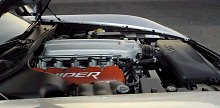 But
you won’t buy Viper for its refinement. Wild performance is still its
selling
point, and the new Viper has enhanced its already remarkable
performance
further. The mega aluminum V10 has gained 300 more c.c. to an
astonishing
8277c.c. (or 505 cubic inches), making it once again the biggest road
car
engine in the world. With so big capacity, you won’t mind it still
relies
on push-rods to activate its 2 valves per cylinder, you won’t mind it
fails
to spin over 6,000rpm, because it pumps out a full 500 horsepower at
5600rpm,
50hp more than before. Yes, five hundred horsepower! you need some
Italian
V12s to outpower it. But
you won’t buy Viper for its refinement. Wild performance is still its
selling
point, and the new Viper has enhanced its already remarkable
performance
further. The mega aluminum V10 has gained 300 more c.c. to an
astonishing
8277c.c. (or 505 cubic inches), making it once again the biggest road
car
engine in the world. With so big capacity, you won’t mind it still
relies
on push-rods to activate its 2 valves per cylinder, you won’t mind it
fails
to spin over 6,000rpm, because it pumps out a full 500 horsepower at
5600rpm,
50hp more than before. Yes, five hundred horsepower! you need some
Italian
V12s to outpower it.
However,
even the
Italian
can’t compete with the tremendous torque generated by the 8.3-litre
American
V10 - at 4,200rpm, there is an astonishing 525lbft available. In the
whole
automotive world, only 3 engines are more torquey: Pagani’s AMG
7.3-litre
V12 (553 lbft), Mercedes’ 5.5-litre twin-turbo V12 (590-664lbft depends
on tuning) and Bentley’s 6.75-litre twin-turbo V8 (645 lbft).
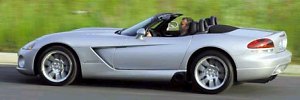 Inevitably,
there is concern whether the mega V10 will make the chassis unbalanced.
In fact, Viper achieved better balance than even Ferrari 575 Maranello
- some 52% of the kerb weight is acted on the rear wheels, perfect!
this
must thanks to the "cab-backward" design that put the whole engine
completely
behind the front axle. Also, the V10 is cast from aluminum to cut
weight,
unlike its truck origin. Besides, the new Viper also positions its
engine
some 2.5 cm lower than before in order to lower center of gravity. Inevitably,
there is concern whether the mega V10 will make the chassis unbalanced.
In fact, Viper achieved better balance than even Ferrari 575 Maranello
- some 52% of the kerb weight is acted on the rear wheels, perfect!
this
must thanks to the "cab-backward" design that put the whole engine
completely
behind the front axle. Also, the V10 is cast from aluminum to cut
weight,
unlike its truck origin. Besides, the new Viper also positions its
engine
some 2.5 cm lower than before in order to lower center of gravity.
As
before, Viper
uses a tubular
steel backbone chassis (like TVR). Bodyshell is low-cost plastic
composite
molding (again, like TVR). There are some new materials however, such
as
the cast magnesium under-dash cross member and roof frames, and carbon
fiber inner supports for fenders. Compare with the old Viper GTS, the
new
car is marginally shorter but wheelbase is 6cm longer. Overall weight
is
reduced by 36kg, making it levels with Porsche 911 Turbo. Suspensions
are
classic double-wishbones all round, made of aluminum. Attached to them
are wide tyres and huge Brembo brakes, whose discs are 355mm large.
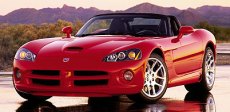 Driving
the Viper is a sensation. The torque and acceleration force is
astonishing
- Motor Trend found it takes 4.1 seconds from 0-60mph and 9.5 seconds
to
100mph. Car And Driver timed even quicker. It is therefore sufficiently
quicker than the next fastest American sports car, Chevrolet Corvette
Z06.
Undoubtedly, Viper is one of the few supercars in the world - the
others
are Ferrari Enzo, Pagani Zonda C12S, Lamborghini Murcielago, Ferrari
575M,
Porsche 911 GT2 and Turbo, TVR Tuscan S and Cerbera 4.5. However,
following
the tradition of American cars, Viper is the cheapest among its rivals
bar the TVRs. Driving
the Viper is a sensation. The torque and acceleration force is
astonishing
- Motor Trend found it takes 4.1 seconds from 0-60mph and 9.5 seconds
to
100mph. Car And Driver timed even quicker. It is therefore sufficiently
quicker than the next fastest American sports car, Chevrolet Corvette
Z06.
Undoubtedly, Viper is one of the few supercars in the world - the
others
are Ferrari Enzo, Pagani Zonda C12S, Lamborghini Murcielago, Ferrari
575M,
Porsche 911 GT2 and Turbo, TVR Tuscan S and Cerbera 4.5. However,
following
the tradition of American cars, Viper is the cheapest among its rivals
bar the TVRs.
Nevertheless,
like TVRs again,
the Viper does not handle and ride like supercars. Yes, its firm
suspension
results in rock-steady cornering. Its heavy steering is race-car-quick
and transmit good road feel. Its huge rubber generates massive grip.
However,
given a twisty road, the Viper suddenly feels too wide to be enjoyable.
Its harsh ride and bump steer discourage you to push harder, unlike
other
good supercars. A Corvette Z06 is easier to drive faster, and more
enjoyable
to do so. The Viper, on the other hand, remains very much a muscle car
in its blood.
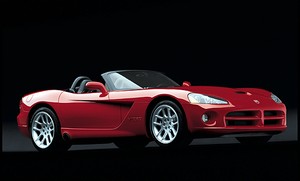 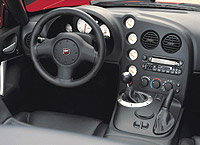
|
| The
above report was last updated on 22 Dec
2002. All Rights Reserved. |
Viper SRT-10 Coupe
|
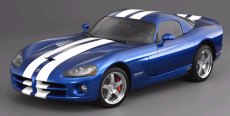 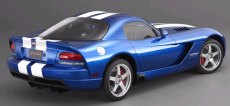
The
Viper
Coupe tries to replicate the first generation Viper GTS, but the result
is not as successful. From design point of view, its double-bubble roof
does not gel with the sleeker, straighter shape of the Viper Mk2,
failing to deliver the “flowing muscle” feel of the Mk1 Viper GTS.
Interestingly, the car looks rather like Bristol Fighter, which is
derived from the Viper powertrain.
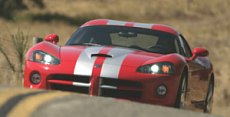 From
engineering point of view, the Viper Coupe did not improve from the
roadster as much as the legendary GTS did. You might remember the old
car was launch as a mid-life update of the Viper, thus it brought a lot
of chassis improvement and significant increase of horsepower. In
contrast, the Viper Coupe has its entire powertrain untouched. The only
thing it improved is a slightly stiffer chassis (thanks to the fixed
roof) and slight reduction of aerodynamic drag, from 0.40 to 0.39,
though that figure is nothing to be proud of. More welcome is a bigger
rear spoiler, which generates 45 kg of downforce at 150 mph. Well,
that's not a big number, but at least better than none. From
engineering point of view, the Viper Coupe did not improve from the
roadster as much as the legendary GTS did. You might remember the old
car was launch as a mid-life update of the Viper, thus it brought a lot
of chassis improvement and significant increase of horsepower. In
contrast, the Viper Coupe has its entire powertrain untouched. The only
thing it improved is a slightly stiffer chassis (thanks to the fixed
roof) and slight reduction of aerodynamic drag, from 0.40 to 0.39,
though that figure is nothing to be proud of. More welcome is a bigger
rear spoiler, which generates 45 kg of downforce at 150 mph. Well,
that's not a big number, but at least better than none.
The roof should raise top speed to 190 mph, but the basic nature of
Viper is unchanged. It is still an old-school American muscle car. Now
facing the new Chevrolet Corvette Z06, the Viper Coupe suddenly seems
outdated. It is rougher, more difficult and more tiresome to drive. You
need to show respect by controlling the throttle pedal carefully,
otherwise will result in wheelspin and oversteer. Sadly, the Viper
Coupe is no longer the fastest American car. Now both Z06 and Ford GT
have surpassed it. |
| The
above report was last updated on 21 Oct
2005. All Rights Reserved. |
Viper 8.4-liter 600 hp
|
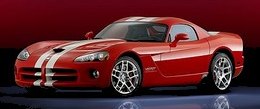 The 2008 Viper
has a number of
improvements, but at the center stage is unquestionably the new
8.4-liter, 600-horsepower engine. That is 90 horsepower higher than
last year's car. The 2008 Viper
has a number of
improvements, but at the center stage is unquestionably the new
8.4-liter, 600-horsepower engine. That is 90 horsepower higher than
last year's car.
When the first Viper was born 15 years ago, its 8.0-liter V10 engine
produced 400 horsepower, or barely 50 horses per liter. Detroit's
outdated OHV design, with only 2 valves per cylinder operated by
high-inertia push rods, limited the breathing and revvability of the
engine. However, also because of the laughably low efficiency, the
Viper engine had plenty of space for improvement. 10 years after its
birth, the second generation Viper came with a 8.3-liter V10 boosting a
full 500 horsepower. If it were a modern multi-valve engine, it would
have been difficult to achieve the same amount of improvement.
Nevertheless, from 500 to 600 horsepower requires far more works.
Chrysler hired British specialists McLaren and Ricardo Engineering to
help improving the engine – not a surprise if you remember the original
V10 was developed by Lamborghini. They developed new cylinder heads
with larger valves, new intake manifolds with dual throttle bodies and
new exhaust to increase breathing by 20 percent. They also increased
compression ratio from 9.6:1 to 10.2:1. To cope with the increased
internal stress, the cylinder block is strengthened, the cooling system
is upgraded and a set of stronger pistons and metal powder forged
con-rods come straight from Chrysler's 6.1-liter HEMI V8 (see 300C
SRT-8). To fit these larger pistons, the bore has to be enlarged by
1mm, thus resulting in 8382 cc.
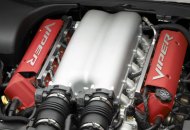 The most surprising addition is variable exhaust valve
timing. This is not the first time VVT is used on an OHV engine –
General Motor's 3.9-liter OHV V6, for example, uses variable cam
phasing on its single camshaft. At high rpm it advances the intake
valve opening, but because the same camshaft also acts on the exhaust
push rods, the timing of exhaust valve opening is also brought forward.
This mean the GM engine enjoys very limited benefits from the variable
valve timing. In contrast, Chrysler's design uses a so-called
"cam-in-cam" construction, that is, a solid intake camshaft located
within a hollow exhaust camshaft (note: most magazines said vice-versa,
but my info comes from SAE's journal "Automotive Engineering
International" which is more trustable). The hollow exhaust camshaft
can rotate for a range of 36 degrees in relation to the inner intake
camshaft. This allows the use of very aggressive intake cam lobes
without hurting low-speed combustion quality and emission. The
"cam-in-cam" mechanism is a clever design, as it is reasonably
effective, cheap to produce (only one cam-phaser is required) and
easily compatible with existing OHV engines. The most surprising addition is variable exhaust valve
timing. This is not the first time VVT is used on an OHV engine –
General Motor's 3.9-liter OHV V6, for example, uses variable cam
phasing on its single camshaft. At high rpm it advances the intake
valve opening, but because the same camshaft also acts on the exhaust
push rods, the timing of exhaust valve opening is also brought forward.
This mean the GM engine enjoys very limited benefits from the variable
valve timing. In contrast, Chrysler's design uses a so-called
"cam-in-cam" construction, that is, a solid intake camshaft located
within a hollow exhaust camshaft (note: most magazines said vice-versa,
but my info comes from SAE's journal "Automotive Engineering
International" which is more trustable). The hollow exhaust camshaft
can rotate for a range of 36 degrees in relation to the inner intake
camshaft. This allows the use of very aggressive intake cam lobes
without hurting low-speed combustion quality and emission. The
"cam-in-cam" mechanism is a clever design, as it is reasonably
effective, cheap to produce (only one cam-phaser is required) and
easily compatible with existing OHV engines.
Overall, the new V10 produces 600 horsepower at 6100 rpm and 560 lb-ft
of torque at 5600 rpm, some 90 hp and 35 lb-ft more than previously.
Max rev is lifted by 250 rpm to 6250 rpm. The Viper is capable of
accelerating from rest to 60 mph in merely 3.7 seconds, 0.4 seconds
ahead of the old car. The ton is reached in 7.9 seconds, a full second
quicker. These figures match supercars like Lamborghini Murcielago
LP640, Gallardo Superleggera and Ferrari F430, if not Ferrari 599 GTB.
However, the most important to the fans of Mopar is that it regains the
title "The Fastest American Car" from arch-rival Chevrolet Corvette
Z06. The new Viper is also the first American production car to enter
the 200MPH Club, thanks to a top speed of 202 mph.
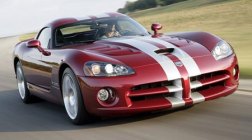 Performance is one matter. How to put the performance down
the road is another matter. Viper used to be praised for muscle car
performance but also criticized for muscle car handling. Therefore
Chrysler also took this opportunity to improve its chassis. Firstly,
the Tremec T56 6-speed gearbox is not only strengthened to handle the
extra power, but also gets modified synchromesh and reduced shift
travel. Now it requires far less effort to operate, although you still
won't describe it as "butter slick". Secondly, the previous heavyweight
clutch has been replaced by a low-inertia twin-plate clutch, which
lightens the pedal a lot. These two changes made the new Viper more
friendly to its driver. Thirdly, a new GKN speed-sensing limited-slip
differential has been adopted to improve traction through corners.
Fourthly, the suspensions get slightly stiffer springs, dampers and
anti-roll bars. Negative cambers and front caster angle increased.
These changes increase roll resistance and cornering grip. To
compensate for the negative effect on ride comfort, it replaces the
previous Michelin run-flat tires (whose stiff sidewalls hamper ride
quality) with new Pilot Sport 2 tires. Finally, the bodyshell of Viper
gets reshaped spoilers and additional ventilation louvers on the bonnet
to increase high-speed downforce. Performance is one matter. How to put the performance down
the road is another matter. Viper used to be praised for muscle car
performance but also criticized for muscle car handling. Therefore
Chrysler also took this opportunity to improve its chassis. Firstly,
the Tremec T56 6-speed gearbox is not only strengthened to handle the
extra power, but also gets modified synchromesh and reduced shift
travel. Now it requires far less effort to operate, although you still
won't describe it as "butter slick". Secondly, the previous heavyweight
clutch has been replaced by a low-inertia twin-plate clutch, which
lightens the pedal a lot. These two changes made the new Viper more
friendly to its driver. Thirdly, a new GKN speed-sensing limited-slip
differential has been adopted to improve traction through corners.
Fourthly, the suspensions get slightly stiffer springs, dampers and
anti-roll bars. Negative cambers and front caster angle increased.
These changes increase roll resistance and cornering grip. To
compensate for the negative effect on ride comfort, it replaces the
previous Michelin run-flat tires (whose stiff sidewalls hamper ride
quality) with new Pilot Sport 2 tires. Finally, the bodyshell of Viper
gets reshaped spoilers and additional ventilation louvers on the bonnet
to increase high-speed downforce.
So now the question is, how does it handle on the road ?
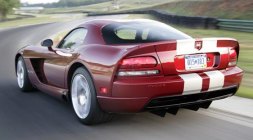 The biggest sensation of the Viper is still its power and
speed. However, now the handling has become a supporting role to them
rather than working against them. You will find the ride a little
smoother, the brakes a little stronger and the aforementioned gearshift
and clutch make it easier to drive fast and slow. But the biggest
difference is the chassis dynamics – the new Viper is more eager to
steer into corners because there is less understeer built into the
chassis. This is made possible by the improved poise, grip and
cornering traction, so Chrysler no longer needs excessive understeer to
tame the beast. At the limit, the Viper is also less easier to
oversteer. The biggest sensation of the Viper is still its power and
speed. However, now the handling has become a supporting role to them
rather than working against them. You will find the ride a little
smoother, the brakes a little stronger and the aforementioned gearshift
and clutch make it easier to drive fast and slow. But the biggest
difference is the chassis dynamics – the new Viper is more eager to
steer into corners because there is less understeer built into the
chassis. This is made possible by the improved poise, grip and
cornering traction, so Chrysler no longer needs excessive understeer to
tame the beast. At the limit, the Viper is also less easier to
oversteer.
Nevertheless, never underestimate the tremendous power and torque of
its mega V10. Viper is not the kind of European sports cars we used to.
Its surefootedness and user-friendliness serve only up to a certain
level. Exceed that level and you will end up in scary oversteer or even
total loss, especially on bumpy roads where its steering could get
nervous. This mean while it is faster in race courses, it won't match a
911 Turbo in the real world. |
| The
above report was last updated on 7 Sep 2007. All
Rights Reserved. |
|
|